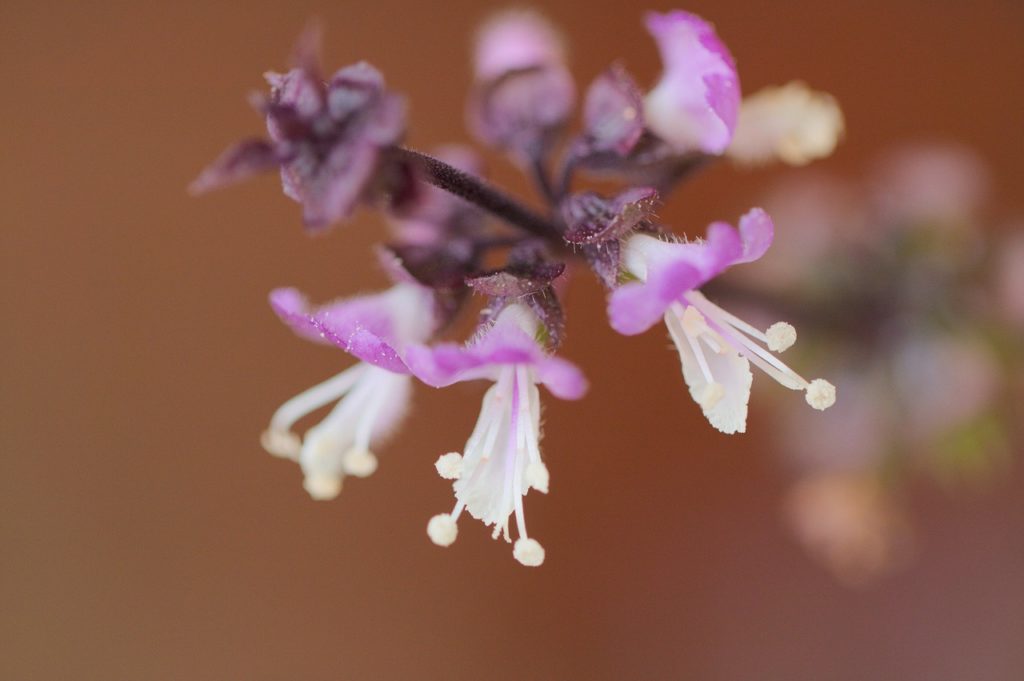
Growing basil at home is a very fun project to take on and if you care for the plant eventually these small flowers will begin to appear on it too.When basil flowers appear, it’s a sign of maturity, but they can compromise the plant’s flavor. Pinching off flowers redirects energy for leaf production, maintaining optimal taste. However, basil flowers are edible and add a subtle floral note to dishes like salads or desserts. Additionally, they attract beneficial insects to the garden. Consider leaving a few flowers to bloom if not harvesting for culinary purposes to support pollinators and extend the plant’s life cycle.
Using Basil Flowers
Basil flowers can enhance salads, desserts, or infused beverages with a delicate floral note. They also attract beneficial insects to your garden. Consider using them as edible garnishes or in herbal teas for added flavor and visual appeal.
Basil Flower Vinegar
To make basil flower vinegar, collect fresh basil flowers and rinse them gently. Place the flowers in a clean, dry glass jar and cover them with vinegar. Seal the jar and let it infuse for 1-2 weeks in a cool, dark place, shaking occasionally. Strain out the flowers and transfer the flavored vinegar to a bottle for storage. Use this aromatic vinegar in dressings, marinades, or as a finishing touch for dishes.
Basil Flower Oil
To make basil flower oil, gather fresh basil flowers and gently wash them. Pat them dry and place them in a clean, dry glass jar. Cover the flowers with a neutral oil like olive oil. Seal the jar and let it infuse for 1-2 weeks in a cool, dark place, shaking occasionally. Strain out the flowers and transfer the infused oil to a bottle for use in cooking or as a flavorful finishing oil.
Basil Flower Tea
To make basil flower tea, steep fresh basil flowers in hot water for 5-7 minutes. Strain out the flowers and sweeten the tea with honey or sugar if desired. Enjoy the delicate floral aroma and subtle basil flavor as a soothing beverage any time of day. Both regular sweet basil and lemon basil are great for making tea with.
Using Basil For Decoration
Flowering basil adds natural beauty to indoor or outdoor settings with its delicate blooms and vibrant green foliage. Its aromatic scent enhances the atmosphere, while attracting beneficial insects. Displaying flowering basil plants adds a touch of freshness and elegance to any space.
Basil Plant Flowers
If your basil plant has flowered, what to do next depends on your purpose for growing it. Most cultivate basil for its aromatic foliage, which emanates scents reminiscent of mint and clove with hints of pepper. Originating in Asia, specifically Thailand, Vietnam, and parts of India, basil is now a staple in global cuisines. Ocimum basilicum, or sweet basil, is the most common variety grown. Flowering may occur due to age, stress, or environmental conditions. To maintain optimal flavor, pinch off flowers as they emerge, redirecting the plant’s energy back into leaf production. Regular harvesting also encourages bushier growth.
Should Basil Flower, And Should You Let It?
When basil flowers, it signals maturity, but it can affect flavor negatively. Pinching off flowers redirects energy for leaf production, preserving optimal taste. However, basil flowers are edible and add a subtle floral note to dishes. Consider leaving a few flowers to bloom to support pollinators and extend the plant’s life cycle. Overall, whether to let basil flower depends on your preference for flavor and the role of the plant in your garden ecosystem.

FAQ
What Happens When Basil Flowers
When basil flowers, it signals maturity, but it can compromise flavor. The plant directs energy to seed production instead of leaf growth. However, the flowers are edible and add a subtle floral note to dishes.
Can You Eat Basil Flowers
Yes, basil flowers are edible. They add a subtle floral flavor to dishes and can be used as garnishes in salads, desserts, or infused into beverages.

